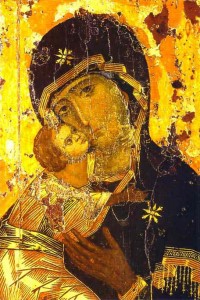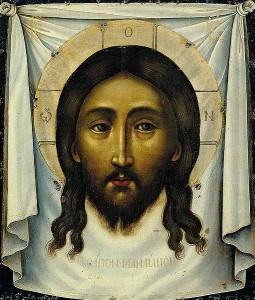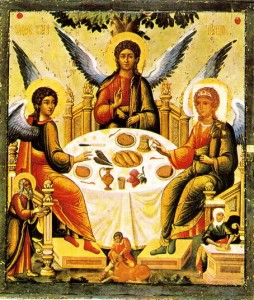 The tradition of Christian icons began in the Roman catacombs of the early church, with roots in early Greco-Roman portraits. These roots can be traced further back to Egyptian sarcophagus portraits. The Greek word “eikon,” literally translated, means “image.” In the eastern Orthodox tradition, an icon represents the Word of God as image. It is theology depicted in line and color, and is therefore called icon “writing.” In creating an icon, we are literally “writing” theology, while traveling our own spiritual journal—acting out our faith through an intentional physical action.
The tradition of Christian icons began in the Roman catacombs of the early church, with roots in early Greco-Roman portraits. These roots can be traced further back to Egyptian sarcophagus portraits. The Greek word “eikon,” literally translated, means “image.” In the eastern Orthodox tradition, an icon represents the Word of God as image. It is theology depicted in line and color, and is therefore called icon “writing.” In creating an icon, we are literally “writing” theology, while traveling our own spiritual journal—acting out our faith through an intentional physical action.
We do not worship icons, as worship is rightly offered to God alone. Icons are venerated, defined by Merriam-Webster as “regarded with reverential respect or with admiring deference, honored with a ritual act of devotion.” Tools of prayer, icons are the presence of absence—the spirit of the image “pressed” onto the surface of the icon through the hands of the icon writer. Icons are not “art” in the modern sense of individual expression, although they have many aesthetic qualities. Icons are a collaboration between the writer and the spirit. The icon writer becomes an empty vessel allowing the Holy Spirit to flow through their hands, and so are generally left unsigned, or penned “by the hand of…”
Traditional icons are created on wood panels, representing the cross and the tree of life, and carefully prepared to receive the image. A layer of linen representing the shroud is attached first to the wood, and then layers of a rabbit skin glue and calcium carbonate mixture called gesso are added. The surface is sanded to a smooth luminous white surface, white being the father of all colors and the gesso, a metaphor for spiritual readiness, is the “preparing of the Bride.”
After an image is chosen, the surface is prepared for gilding with the application of layers of animal glue and red clay, or Armenian bole. Red clay is used not only for its physical properties of silkiness and richness of color but also serves as a reminder of our beginnings, representing the earth, and humanity in its natural unenlightened state. In Hebrew the word Adam has three root meanings—man, red, and clay.
Gold represents divine knowledge, divine wisdom, heaven, enlightenment. The gold is applied before painting—physically—because gold will stick to an already painted surface. Spiritually, we must first merge the earthly with the divine before proceeding with the act of painting. A warm, moist breath activates the glue/bole mixture, and the gold is then applied. In the physical process of gilding with the breath, the act of creation is symbolically reenacted—as God breathed life into clay to create man, so we breathe on the clay to bring life with gold.
The act of gilding with this transformational breath requires a meditative state. Physically, the malleability of gold requires that you move with it. Symbolically, to succeed, the ego must let go, to let God move through us. Difficulty in covering the clay with the gold represents a fear of the ego being annihilated. The ego is fighting for control—it does not want to submit to the process. The faulting, or patching, of gold is an acceptance of our imperfections, a trust in the process, in oneself.
Icons are traditionally painted with egg tempera, a handmade paint using natural pigments such as minerals, vegetable and animal sources combined with the yolk of an egg as the binder. The yolk is rolled in the palm to remove the white, an act of intimacy connecting one more deeply to the earthly materials and the kingdom of God. The colors used have a liturgical history and connection to the particular image, developed over time and varying from place to time period. When the painting is complete, the name is written, and the icon is varnished. The icon is then ready to be blessed and used for contemplation.
 Icons are a window into the mystery of faith, a meditative tool. The making of sacred art naturally illuminates and develops the spiritual life of the individual who creates it. The preparation of materials, such as wood, pigments, and gold, represents the preparation of the spirit, each phase of the work requiring another level of readiness. Obstacles arising in the technical aspects of the work represent a spiritual aspect that needs attention, and present an opportunity for the seeker to submerge further into the process. This practice is a metaphor for the spiritual journey, from the preparation of the wood, to the application of gold, to the rolling of the egg yolk in the palm to make paint.
Icons are a window into the mystery of faith, a meditative tool. The making of sacred art naturally illuminates and develops the spiritual life of the individual who creates it. The preparation of materials, such as wood, pigments, and gold, represents the preparation of the spirit, each phase of the work requiring another level of readiness. Obstacles arising in the technical aspects of the work represent a spiritual aspect that needs attention, and present an opportunity for the seeker to submerge further into the process. This practice is a metaphor for the spiritual journey, from the preparation of the wood, to the application of gold, to the rolling of the egg yolk in the palm to make paint.
We honor God in the reverent use of His gifts, and in the process deepen our connection to the world, to each other, and to Him. Mindfulness is the first essential step on the journey to spiritual perfection. We are not perfect; we can only have perfect intent. The mind is focused inward, emotional reactions to the world are stilled. All of one’s essence is concentrated on inner silence. This is ecstasy—a joy of complete stillness and a realization of the intensity of presence. We are then in the presence of God.
by Patricia Miranda, 2011
